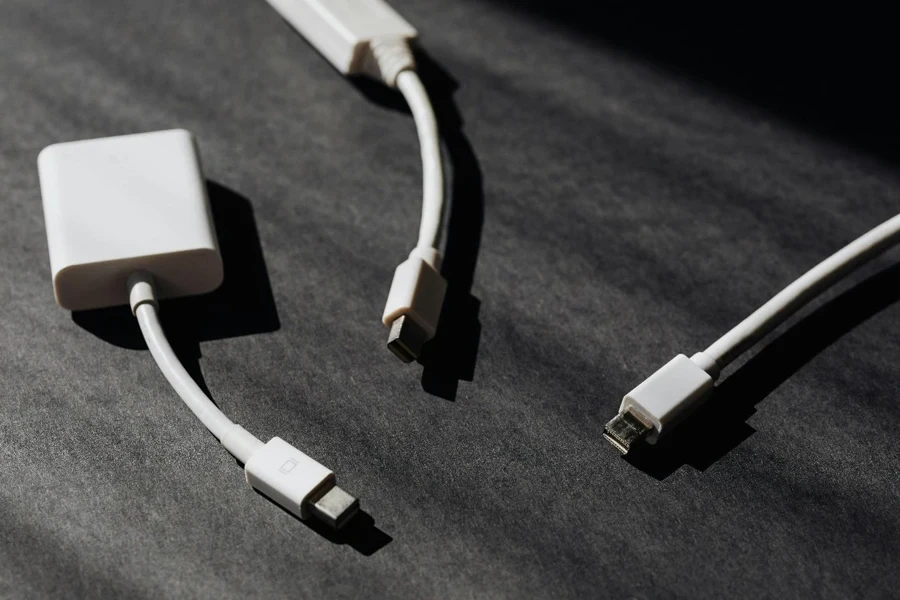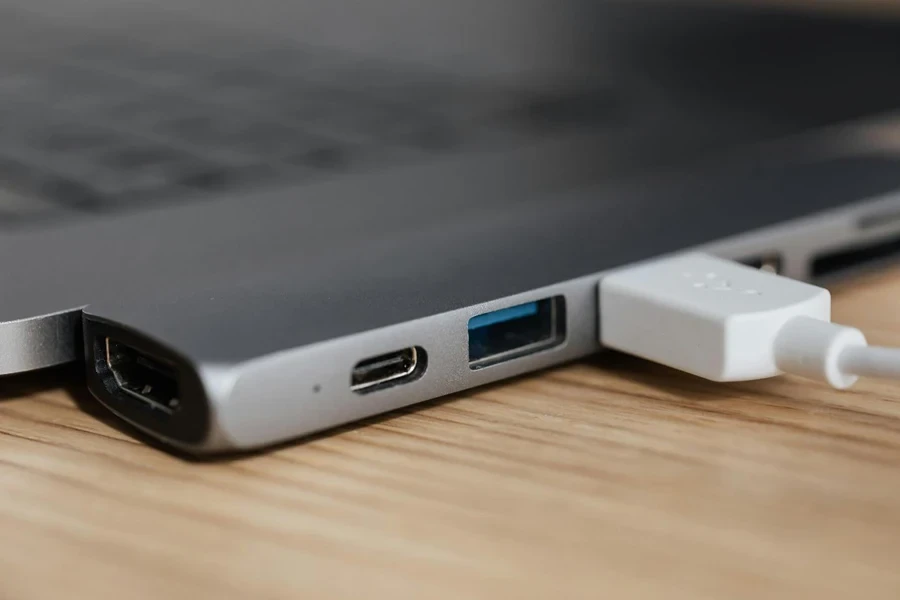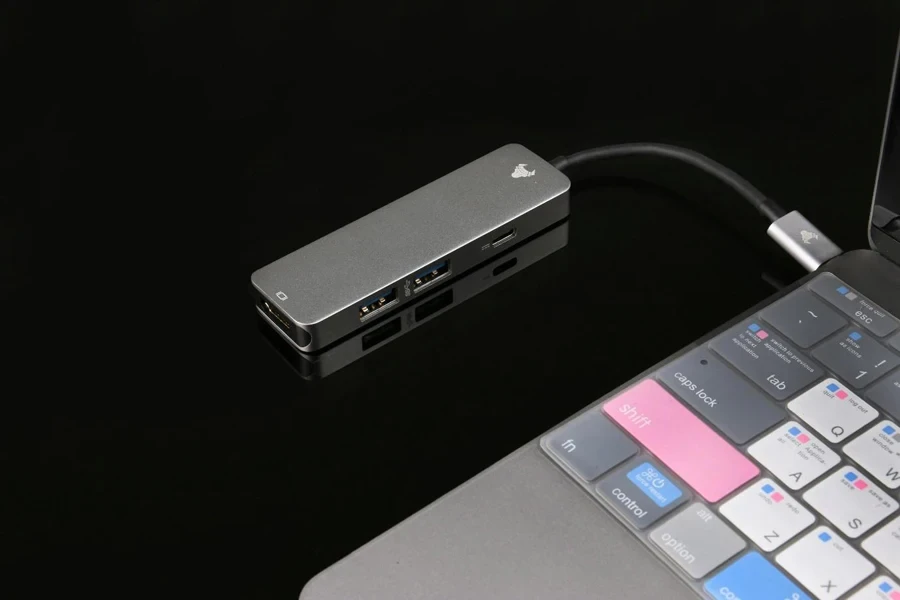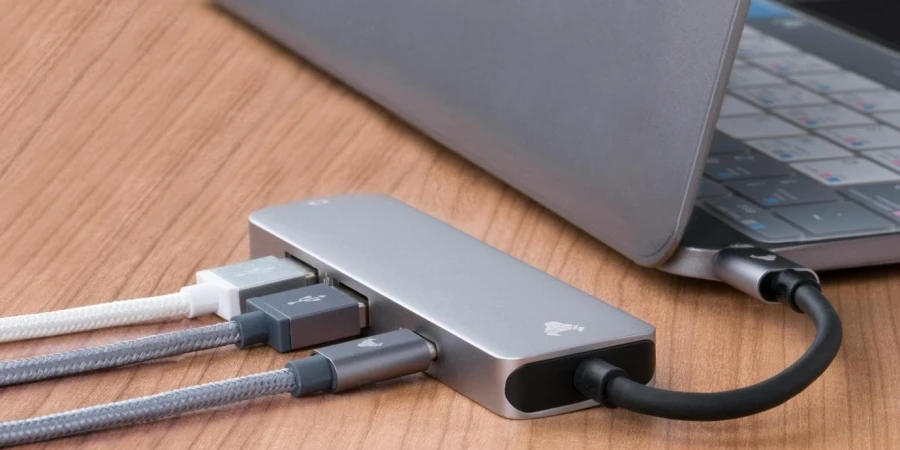USB hubs play a big role in today’s fast-paced technological world by providing improved connectivity options for businesses and retailers alike. As the need for quicker data transfer and broad device compatibility increases significantly, professional buyers must stay informed about market trends to make ideal purchasing choices.
This article explores the current trends in the market and showcases the innovative features and popular models influencing the evolution of USB hubs today. By staying updated with these advancements, businesses can be confident in having the tools to address their connectivity requirements efficiently.
Table of Contents
● Market overview
● Key technology and design innovations
● Top-selling models driving market trends
● Conclusion
Market overview

Market size and growth
The worldwide market for USB hubs is projected to hit $8.4 billion by 2032, with a growth rate of 7.6% between 2023 and 2032. This substantial expansion can be attributed to the rising need for efficient data transfer and the widespread usage of USB-C technology.
The increasing number of interconnected gadgets in sectors such as the information technology (IT), gaming industry, and the smart home niche is driving the demand for USB hubs capable of accommodating multiple connections simultaneously. With companies and merchants increasingly depending on these hubs for the functioning of their operations, the market is expected to grow.
Regional insights
In 2022, the USB hub market was mostly led by North America due to its developed technology infrastructure and the strong presence of key industry players. The region had a significant market share in 2022 fueled by high demands from IT and gaming sectors.
The Asia Pacific region is anticipated to experience a high growth rate in the coming years due to the swift digital transformation of economies, the increasing presence of IoT devices in everyday life, and the gaming industry expanding rapidly across borders. China and India lead this wave alongside Japan, making Asia Pacific a prime destination for businesses seeking to leverage prospects.
Key market segments
The market for USB hubs is divided based on their type and the applications they serve. The dominance of USB 3.0 hubs in the market can be attributed to their faster data transfer speeds, which are four times higher than that of USB 2.0 hubs. This makes them a popular choice among businesses in need of high-speed connectivity. On the other hand, the growth prospects for USB 3.1 hubs are promising due to their capacity to handle data transfer speeds of up to 12 Gbps.
There is a high demand in the consumer sector of the market due to the rising trend of digitalizing work environments and the widespread adoption of sophisticated technologies such as IoT and big data. Additionally, there is progress in the sector, especially with the surge in remote work arrangements and the expanding domain of professional gaming.
Key technology and design innovations

USB4 and Thunderbolt 4: Pushing the boundaries of connectivity
USB 4 and Thunderbolt 4 have established benchmarks in USB hub innovation by providing data transmission rates of up to 40 Gbps. Compared to USB 3.1 performance, this is a leap that enables the connection of 4 K monitors or a single 8 K monitor and facilitates PCIe data transfer. The Thunderbolt 4 standard requires backing for four ports and universal USB-C gadgets, enhancing flexibility for advanced configurations that demand top-notch performance.
These ports also come with a power supply (PD), enabling connected devices to charge efficiently while transferring huge amounts of data.
Wireless USB hubs: Embracing cable-free environments
Introducing USB hubs signifies flexibility and connectivity without cables or wires. These hubs use technologies like WiGig (Wireless Gigabit) to attain data transfer rates to connections reaching up to 7 Gbps. As a result, they are well suited for demanding tasks such as streaming 4K video or linking peripherals.
Wireless USB hubs are becoming a key feature in home setups as they allow for the seamless coordination of various devices without the hassle of dealing with cables cluttering the space. For example, one useful aspect of a USB hub is its ability to effortlessly link and oversee devices such as speakers and security cameras along with other IoT gadgets to ensure an efficient network operation.
Integration with smart devices: Expanding the role of USB hubs

USB hubs are now parts of setups in places with many connected devices. These hubs work with protocols like Zigbee and Z Wave to connect home gadgets like lights and security sensors.
USB hubs are components in reality (VR) and augmented reality (AR) environments to efficiently handle the swift data transfer rates necessary for immediate processing tasks. They facilitate linking high-definition cameras, motion sensors, and haptic feedback devices that rely on less delay and ample bandwidth to operate optimally.
USB hubs come into play in medical settings connecting different diagnostic tools, like ultrasound machines and digital imaging systems. They ensure smooth and quick data exchange, which is essential for precise results.
Design evolution: From basic to multifunctional hubs
Modern USB hubs now come with advanced capabilities to better meet the requirements of today’s users. Power delivery (PD), a feature in high-end USB hubs nowadays, is designed to provide up to 100 watts for charging laptops and various devices without compromising fast data transfer speeds.
A notable advancement is the integration of NVMe-based SSDs into USB-C hubs to expand storage capacity with read/write speeds exceeding 900 MBps. These versatile hubs aim to streamline connectivity by incorporating built-in card readers and HDMI outputs while also including Ethernet ports within a unique design to minimize the requirement for adapters.
The increasing need for devices that link up and improve the effectiveness and capacity of user workflows is evident in this level of integration and functionality.
Top-selling models driving market trends

Sabrent HB-B7C3: The powerhouse for desktop setups
The Sabrent HB-B7C3 is a leading model in the desktop USB hub category, renowned for its 10-port capacity that caters to power users needing multiple device connections. This hub includes seven USB 3.0 ports for high-speed data transfer at up to 5 Gbps, along with three dedicated charging ports that deliver higher currents for fast-charging smartphones, tablets, and other gadgets. Each port features an individual power switch, giving users precise control over their connected devices. The Sabrent HB-B7C3’s robust design and reliable performance make it a best-seller, especially among professionals who manage a variety of peripherals like external hard drives, printers, and cameras.
Anker PowerExpand 4-in-1 USB-C Hub: Premium portability
Are you looking for an efficient hub? The Anker PowerExpand 4-in-1 USB-C Hub is a good option for those on the go. Tailored for MacBooks and Ultrabooks users, this hub offers two USB-A ports with 5 Gbps data transfer rates. It also includes a handy 256GB SSD for extra storage when you’re out and about. The device features a HDMI port that can handle 4k display output, making it perfect for anyone who needs to link up to screens. Moreover, the 100-watt USB-C power pass-through guarantees that your laptop stays charged during long work hours.

Anker 541 USB-C Hub for iPads: Specialized for creative tasks
The Anker 541 USB-C Hub has been crafted specifically for iPad users with the creative and content creation fields in mind. The hub easily attaches to the iPad and offers a USB-A port, HDMI output, SD card reader, and a 3.5mm audio jack. Its convenient snap-on design ensures it stays firmly attached while being used, making it especially handy for video editors and photographers needing access to media sources and display options. The Anker 541 also allows for fast data transfer speeds of up to 5 Gbps so that users can easily move files between devices. It is a popular choice for those seeking functionality in a compact device.
Inatek HB2025AL: High-speed data transfer champion
The Inateck HB2025AL is a top choice for individuals who value performance above all else in a USB hub model. With four USB 3.2 Gen 2 Type-A ports that handle data transfer speeds of up to 10 Gbps, this hub is ideal for professionals dealing with large data files, like video editors or individuals overseeing databases. Its compact and sturdy design allows for desktop or tablet use. Its speed features effectively manage data transfer operations, making it a popular choice for users seeking reliable and speedy connectivity options.
Sabrent HB-U3CR: Compact and functional
If you’re seeking a reliable hub option, the Sabrent HB U3CR has three USB-A ports and an integrated SD and microSD card reader. This hub is well-loved by individuals who often handle memory cards, photographers, and videographers. Operating at 5 Gbps data transfer rates, it guarantees convenient file access. The aluminum construction of the Sabrent HB U2CR does not just add durability but also gives it a sleek and stylish look that appeals to users seeking functionality without compromising aesthetics.
Conclusion
USB hubs play a big role in today’s world and shape how we connect in different industries. With innovations such as USB 2 and Thunderbolt 3, hubs are not just boosting data transfer rates but also broadening their capabilities with perks, like links and integrated storage solutions.
The need for desktop units and convenient mobile options is on the rise as businesses strive to handle devices efficiently and maintain smooth operations. Through technological advancements, USB hubs are set to meet the expanding connectivity requirements of professionals and various industries globally.




